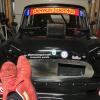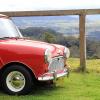Vac-Less Options With Dcoe
#1

Posted 17 January 2025 - 04:11 PM
#2

Posted 17 January 2025 - 05:29 PM
The advantage of the vacuum advance is that it gives you better lean burn / fuel consumption with minimum throttle, such as cruising on the highway.
The advantage of the DCOE is that it gives you a richer mixture and minimum air obstruction with maximum throttle, accelerating / going flat out, such as fast / slow round bendy side roads, when there isn't much vacuum in the manifold to advance the timing.
The construction, operation and application of an SU is more compatible with vacuum advance than a DCOE, so it wouldn't be as advantageous to your fuel consumption, if you decide to keep it..
#3

Posted 17 January 2025 - 05:50 PM
Running an A123 with a programmable advance curve is the way to go. Setting a DCOE up with vacuum advance is more complicated than going without the vacuum advance. I never tried setting up a DCOE with a vacuum advance because the DCOE was not set up to provide a vacuum signal with the throttle butterfly and "in my day" there were no programmable distributors to get no vacuum at idle and then get vacuum at light throttle. The carburetor needed a vacuum hole just after the throttle butterfly was tipped open from its idle position. These days you can just program the A123 to ignore the vacuum signal until 1500 rpm. If you can rig a manifold vacuum signal from both manifold ports you should get a steady vacuum signal and then who knows? You might be the first to find out how much a vacuum distributor helps a DCOE set up.
Anyway, assuming you go vacuumless, set your initial timing for 12 BTDC, advance curve to start at 1500 rpm, and your total advance to 32 degrees at 3000 rpm. That should get you started. The ideal settings require a chassis dyno or similar sophisticated tuning.
The difficult part with a DCOE is setting the idle circuit. The DCOE was only designed to have one cylinder per choke and when you have two cylinders the idle circuit is fussy. Ideally you want the throttle butterfly to PARTIALLY cover the first hole in the progression circuit. That is the hole closest to the manifold. Adjust idle timing and mixture to get the car to idle there. If the throttle is open fully past the first hole it gets difficult to control the idle speed and mixture. Try advancing the idle timing more and see if that gets the butterfly in the correct position. If the throttle butterfly is fully past the first hole in the progression circuit AND you already have 12-15 degrees timing at idle AND your mixture is already rich AND you are really brave you could try enlarging the idle hole, that is what the Weber engineers would do. I never had the courage to try it!
Edited by crock, 17 January 2025 - 06:05 PM.
#4

Posted 17 January 2025 - 06:20 PM
Running an A123 with a programmable advance curve is the way to go. Setting a DCOE up with vacuum advance is more complicated than going without the vacuum advance. I never tried setting up a DCOE with a vacuum advance because the DCOE was not set up to provide a vacuum signal with the throttle butterfly and "in my day" there were no programmable distributors to get no vacuum at idle and then get vacuum at light throttle. The carburetor needed a vacuum hole just after the throttle butterfly was tipped open from its idle position. These days you can just program the A123 to ignore the vacuum signal until 1500 rpm. If you can rig a manifold vacuum signal from both manifold ports you should get a steady vacuum signal and then who knows? You might be the first to find out how much a vacuum distributor helps a DCOE set up.
Anyway, assuming you go vacuumless, set your initial timing for 12 BTDC, advance curve to start at 1500 rpm, and your total advance to 32 degrees at 3000 rpm. That should get you started. The ideal settings require a chassis dyno or similar sophisticated tuning.
The difficult part with a DCOE is setting the idle circuit. The DCOE was only designed to have one cylinder per choke and when you have two cylinders the idle circuit is fussy. Ideally you want the throttle butterfly to PARTIALLY cover the first hole in the progression circuit. That is the hole closest to the manifold. Adjust idle timing and mixture to get the car to idle there. If the throttle is open fully past the first hole it gets difficult to control the idle speed and mixture. Try advancing the idle timing more and see if that gets the butterfly in the correct position. If the throttle butterfly is fully past the first hole in the progression circuit AND you already have 12-15 degrees timing at idle AND your mixture is already rich AND you are really brave you could try enlarging the idle hole, that is what the Weber engineers would do. I never had the courage to try it!
Now that would be interesting setting up a small line from both circuits. I would if I could tig in some bungs for said lines but that’s above my pay grade. I may try the wireless 123d for the A+ that spares sells. I was told I can cut out the vac signal out of the tune and like you said program the advance in!
#5

Posted 17 January 2025 - 07:09 PM
You fit a suitable dizzy. Or you fit mappable ignition.
but it all depends on your engine build.
#6

Posted 17 January 2025 - 09:53 PM
Eg
https://weber-carbs....-dellorto-dhla/
You’ll need to have a vacuum port on each barrel/manifold runner to give a decent vacuum signal (join both barrels with a T piece then send to the vac advance), otherwise it’s very choppy at idle
If you have a programmable 123 unit, you can program it to not add advance at idle which will give a similar result to ported vacuum - ie add advance at part throttle for better economy, throttle response and engine longevity.
There’s not really any downsides to a properly setup vacuum advance system (or MAP based system) for a road engine
Edited by timmy850, 17 January 2025 - 10:53 PM.
#7

Posted 18 January 2025 - 12:32 AM
Could you show me where you put that port on your setup? Just curious. Thank youI have successfully used vacuum advance on my Dellorto DHLA which is very similar to a Weber DCOE. Many of the carbs have a little vacuum port cap, you can remove this and add an adapter
Eg
https://weber-carbs....-dellorto-dhla/
You’ll need to have a vacuum port on each barrel/manifold runner to give a decent vacuum signal (join both barrels with a T piece then send to the vac advance), otherwise it’s very choppy at idle
If you have a programmable 123 unit, you can program it to not add advance at idle which will give a similar result to ported vacuum - ie add advance at part throttle for better economy, throttle response and engine longevity.
There’s not really any downsides to a properly setup vacuum advance system (or MAP based system) for a road engine
By the way I think it’s crazy that I’ve done so much research and this is the first time of someone mentioning that!!!
Edited by Zlevin23, 18 January 2025 - 01:07 AM.
#8

Posted 18 January 2025 - 01:41 AM
This is how I had it set up.
Some times the ports are used in factory manuals to connect vacuum gauges to sync each carb barrel together.

#9

Posted 18 January 2025 - 02:50 AM
Reason # 553 why Dellortos are better than Webers......
#10

Posted 18 January 2025 - 02:53 AM
And some Dellortos don’t have them
#11

Posted 18 January 2025 - 05:29 PM
Reason # 553 why Dellortos are better than Webers......
My 45 Weber has these ports!
Thank you for the info! You just saved me 400 bucks on a 123d that I would have had to get. Instead I just bought those fittings
Edited by Zlevin23, 18 January 2025 - 05:29 PM.
#12

Posted 19 January 2025 - 04:45 PM
Shooter
Attached Files
#13

Posted 19 January 2025 - 07:06 PM
I'm not sure if this helps, but MK1 minis had this little chamber thing in the vacuum system, which I presume was meant to dampen out the signal from the carb(s)
Shooter
I always thought that was to prevent fuel reaching the vacuum advance diaphragm.
#14

Posted 20 January 2025 - 10:41 AM
I'm not sure if this helps, but MK1 minis had this little chamber thing in the vacuum system, which I presume was meant to dampen out the signal from the carb(s)
ShooterI always thought that was to prevent fuel reaching the vacuum advance diaphragm.
It is called "The Flame Trap".
1 user(s) are reading this topic
0 members, 1 guests, 0 anonymous users
















